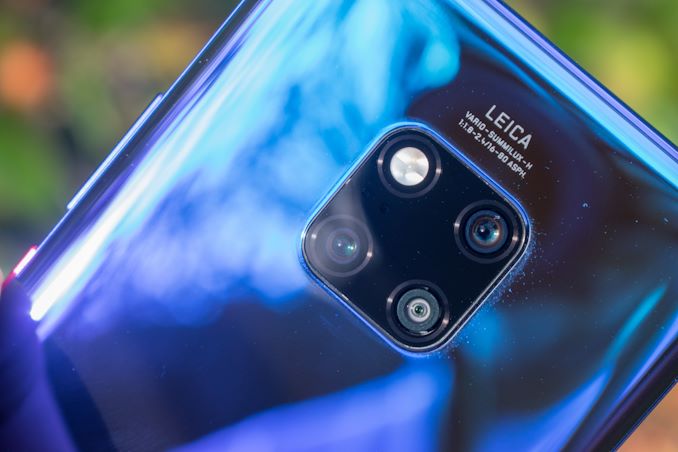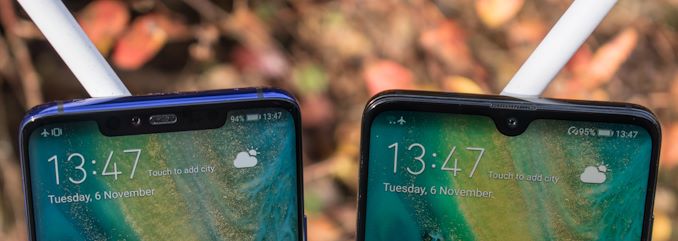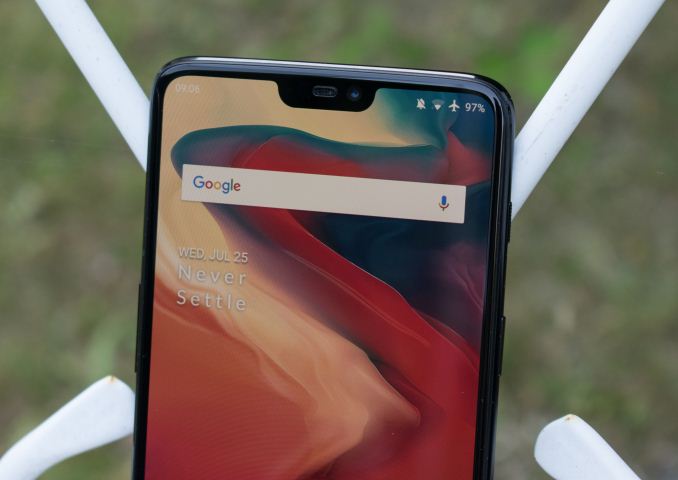AnandTech Year In Review 2018: Flagship Mobile
by Andrei Frumusanu on December 28, 2018 12:00 PM EST- Posted in
- Smartphones
- Apple
- Samsung
- LG
- Huawei
- Mobile
- SoCs
- OnePlus
- Year In Review

As we’re drawing to a close of the calendar year, it is time to look back and revisit what 2018 has brought to the mobile space. Unlike the PC industry, the mobile space follows a quite unrelenting and precise release schedule – meaning that we’re guaranteed new products every year: This can be a double-edged sword for new flagship mobile devices, as new technologies can be either ready at the leading edge of a new product cycle – or in the worst case they can miss the current generation altogether by a few months and have to be relegated to the next generation. Overall, smartphone companies have an incredibly complex task at hand in attempting to deliver products that not only represent an improvement to last year’s devices, but also to be able to distinguish themselves from the current competition. In this piece, we’ll have a closer look at the distinguishing trends of 2018 and how major players have executed their strategies this cycle.
How 2018 Will Be Remembered: Major Smartphone Camera Leaps
If I were to be asked what 2018’s flagship smartphones most defining characteristic would be, then I’d say their cameras. Essentially every vendor in 2018 has made significant leaps in terms of their camera performance, improving quality and adding new features. This year more than ever, we saw a significant amount of products make the camera their key selling point.
Starting off early in the year, Samsung lead the way with the release of the Galaxy S9. The S9’s camera on paper wasn’t too unusual, apart from the fact that the main camera module employed a new innovative dual-aperture mechanism. Samsung’s gains here were defined by sheer improvements of the camera hardware: The new sensor along with the new lens mechanism had raised the bar in terms of overall detail and sharpness, an aspect of the camera in which Samsung still maintains top marks up till today.
Another player whose camera improvements can be attributed to significant hardware leaps is Apple. The new iPhone XS and XR’s new camera module saw a major improvements in the sensor, with new larger pixels as well as a notably improved DTI implementation. The combination of great hardware and robust and consistent software processing made the new iPhone XS one of the best cameras of 2018.
The Year Where Camera Software Outshone Camera Hardware
Although Samsung’s and Apple’s camera improvements were significant – it was more or less an expected result of the newer generation hardware. While the hardware advances this year were solid, nothing left a quite an as quite as lasting impression as Huawei’s new computational photography on the P20 Pro and Mate 20 Pro.
[ Mate 20Pro ] - [ P20Pro ] - [ Pixel 3 ]
[ iPhone XS ] - [ S9+ ] - [ LG G7 ] - [ OnePlus 6 ]
Night mode on Huawei devices was something that was part of the company’s camera experience for a couple of years now – but it required use of a tripod to be able to get good results. The introduction of a new revamped hand-held Night Mode on the P20 Pro sparked a new era of true computational photography, achieving new levels of low-light performance that in the past would have been hard to imagine on a smartphone.
It’s only been recently, and almost half a year later that other companies followed suit: Most notable was Google’s “Night Sight” mode that was announced along the Pixel 3, with the feature also coming to the Pixel 2 and original Pixel. Here Google was able to one-up Huawei in terms of the low-light processing prowess.
I do think Huawei deserves a lot of credit for being a pioneer in terms of its use of computational photography: We’ve seen already many companies such as OnePlus and Xiaomi release new models and new camera software updates which bring night mode implementations of their own. I really do expect this feature to be a key checkmark item for smartphone vendors in 2019, with essentially all other major vendors following suit with new custom implementations.
The More Cameras the Merrier?
Another big trend by which 2018 smartphones will be remembered by, is the increasing amount of cameras on a smartphone. This year in particular has been pretty much the year in which having a telephoto module on your smartphone has become a mainstream feature. There’s still exceptions to this, particularly the smaller S9 from Samsung, along with Google’s Pixel phones. Vendors who don’t have a telephoto module per se, do still offer some added functionality with a second sensor; LG continued with its use of a wide-angle lens in the G7, while vendors such as OnePlus advertise the second sensor as being used for depth information.
In the last months of 2018 we saw the increase in camera modules go quite in the extreme: Instead of having to choose between either a telephoto or a wide-angle module, vendors such as Huawei, LG and Samsung have now started offering the trifecta of rear-camera configurations. Huawei’s introduction of a wide-angle module in the new Mate 20 and Mate 20 Pro make for a great addition to the capture experience, and we now finally see an alternative to LG in terms of seeing another major device offering the feature. Conversely, we also saw LG going the three-camera route in the new V40, adding for the first time a telephoto module in its new flagship. Much like the “night mode”, I expect the camera trifecta to be a key checkmark feature for flagship devices in 2019.
How 2018 Will Also Be Remembered: The Display Notch and its Repercussions
Apple’s 2017 iPhone X was the phone that pretty much “popularised” the display notch. While Apple wasn’t exactly the first company to introduce this, it paved the way for other companies to introduce designs that, wouldn’t it have been for the iPhone X, maybe wouldn’t have come to market with the designs that they did end up with.
Now I personally never really felt all that strongly about display notches for most of 2018: It was just something that I acknowledged to be there, but otherwise wasn’t neither a big positive nor negative for the phones. Huawei’s, LG’s and OnePlus’s first implementations this summer all worked quite seamlessly, and all of them allowed for “blacking out” the notch ears if one so wished.
Among Android devices, I think the only questionable implementations of the notch were on the Pixel 3 XL and on the Mate 20 Pro. The former just had an absurdly tall double-height notch that aesthetically just really wasn’t pleasant, all while having much inferior software options in terms of customising the “ears”. The Mate 20 Pro’s notch is the one that was most similar to the iPhone X; both in terms of functionality as well as design. Here I think the wider design actually hindered things on the software side, as I felt there wasn’t enough space left for the notification bar elements.
Now there’s arguably a lot of discussion if the display notch is worth it, but one thing that every company seems to agree on is that this is just an interim solution while everybody is working towards the goal of bezel-less devices. In fact, some companies this year have resorted to some quite radical designs; The Oppo Find X has a motorised camera housing sliding out of the top of the phone, hiding both front-facing and rear-facing cameras beneath the front screen and back glass. Another implementation is adopted by Honor, Xiaomi and Lenovo, devices such as the Honor Magic 2, Mi MIX3 and the new Z5 Pro, where the whole front-screen is mounted on a sliding mechanism, while the main body houses the internals as well as the camera hardware.
These solutions are quite innovative, however I do think they’re impractical and sacrifice a lot (Increased weight, lesser or no IP rating, and available thickness available to the camera modules) just for the goal of having a bezel-less display.
In general I feel less certain about where 2019 will lead us in terms of solving the display bezel/notch issue. Obviously there’s all eyes on Samsung as being one of the only hold-outs for most of 2018 who have resisted in adopting any model with a notch – here the company was quite public about its plans to adopt “Infinity-V” and “Infinity-O”, the former which is a usual V-shaped notch, while the latter will be using hole-in-active-display design.














65 Comments
View All Comments
quiksilvr - Friday, December 28, 2018 - link
If the Samsung lineup loses the headphone jack it will all be over. I really wished phone makers would put a USB-C Port on the top and a second on on the bottom so users can mix and match which ones can be used for what (top/bottom for headphones and top/bottom for charging simultaneously, top and bottom for headphones so two people can listen without tangled wires, etc.). The complete lack of USB-C headphones in the market is another major reason why people still want 3.5 mm jacks on their phones. You can't just remove the port and give us a dongle; that is not a solution.zodiacfml - Sunday, December 30, 2018 - link
I made a similar comment in Gsmarena on their article on dual things on smartphones. I suggested a dual type-c port and Asus narrowly did that with their RoG gaming phone.I doubt companies would. The reason they removed the jack is to save money, so another type-C port will be more expensive than retain the jack
Quantumz0d - Sunday, December 30, 2018 - link
Exactly, and to Andrei - First of all the Audio port 3.5mm jack piece is excellent, no press site mentions this at all all praise the iPhone and others and fall exactly what the OEMs put their Kool-aid out. Thanks for that.There are a lot of shortcomings or wrongly mentioned points there, likewise how you put a 6T vs 6 and mentioned Apple included a powerful taptic engine in that space. The shortcoming here is Apple taptic engine reason is given because of the hardware chipset design the way how we perceive it. They show the chipset doesn't have space. But somehow the PCB design is always varied among 6 - 6S and 7 and so on, the PCB design will have space, look at how A12 stacked chipset in iPhone X, they folded the chipset and filled with via holes and connected them like OG iPhone. And Apple has the strength and resources to do that, not only that how the Taptic engine size varies among all iPhones and iDevices. Apple blatantly stupidly moved to that because of their user base who only knows Bose / Beats trash tier sound quality and the Made for i device program which has licensing costs and their Wireless Market. Read the below Statista report on the 2016 marketshare on the wireless devices.
https://www.soundguys.com/was-ditching-the-headpho...
Next the Note 9, why there's no mention of the Note 9 PCB and internal design ? while the 6T is a good point but that Chinese company CEO is always a PR face for asking polls and etc while saying the In Display FPS is the reason which is stupid, Meizu 16 has it with exactly same design as Samsung S9 and then the Note 9 packs this massive sized battery with S-Pen and has a same taptic engine like iPhone on the home button on screen, and packs the best in class display panel and almost everything in a phone from Health SpO2 sensor to the damn USB to HDMI output. And why not even look further like Vivo's Nex S smartphone, It has this popout camera with massive 4000mah battery again, with robust construction of the moving part, has a powerful Hi-Fi DAC chip as well from Cirrus Logic, ofc the "King of smartphone Audio LG, with their V30" I have one, V30S ( More on these Hi-Fi in the second comment)
We can clearly see how the marketing beast pays off, how the new DRM/walled garden ont he lack of 3.5mm universal jack war rages on against consumer, they aren't shooting in foot, they are shooting us in the foot forcing us to move to those planned obsolescence stupid BT audio. I had a Bose Soundsport wireless from my friend which sound rubbish vs a simple IEM like Fiio EX1 II due to the fact that it needs LDAC - An expensive license from Sony, aptX only 320Kbps limit, AptXHD ~700kbps data rate and latency issue tons of problems while it's super simple to design a device which can house a simple analog port, it was 1 year old and guess what ? the battery was dead, how are we supposed to iron that out ? Li-Ion technology is a failure on longevity of the devices, Apple is notorious for lack of user intervention on customizing or upgrading or repiring their products and their abject failure on not including the headphone jack in the latest iPad Pro which is structurally flawed worse than the 6 bend gate Touch Disease IC issue. Google should be called out as well, after blasting Apple with their cheap iPhone clone Pixel Gen 1 having a headphone jack and dropping it on Gen 2 saying "enjoy high quality digital sound" - master BS from Google, Audio as you said is analog and no way we can hear digital BS, coming from such prolific company like Google, and going to the peaks like removing it from Slate ? Omega class retardedness and people are fine with it, that Huawei going proprietary SD slot ? worst. Such lame attempts to mimic Apple on ecosystem walls and lockdowns ? and on the audio side on saving a few bucks and asking more for the trash grade wireless sets which are expensive and go to dumpster in 1 year ? Checkout this Verge piece.
https://www.theverge.com/2017/10/5/16426754/pixel-...
It's a shame how the industry from the OEMs to the damn press sites are so biased towards the companies losing out their first hand reviews or whatever YT videos or articles to generate stupid clicks, a shame Idk how people are happy doing their shilling jobs for companies. Apple is so successful in ruining one of the best things in the history of technology, a pristine proper Audio listening through the 3.5mm analog 100 year old jack which simply does the job well without any issues.
Wish you should have covered it on a vast spectrum of devices rather that 6T but however the 6T is a good device to pick, since it has too much of fan following or highly praised for it's stupidity of under performing specs.
GreenReaper - Friday, December 28, 2018 - link
Realistically the answer to the audio question is to a) not buy flagships at all, if possible, and b) only buy phones with 3.5mm sockets. Send a signal through your purchases. I'm doing my part! 😼ahamling27 - Friday, December 28, 2018 - link
I'm super pleased with my OnePlus 6. 3.5mm jack, and everything I need in flagship. Now the 6t on the other hand... 😒SkyBill40 - Friday, December 28, 2018 - link
Samsung, "providing the best audio experience in the mobile space", is cute. They're nowhere close to the best and multiple tests across the spectrum have shown that rather clearly. They are often outdone by their peninsula rival, LG, who has a significantly better DAC built into their phones.Andrei Frumusanu - Friday, December 28, 2018 - link
This is wrong. LG does have a good DAC, but it has its drawbacks. The quad-dac feature serves just as a way to increase voltage, but it also increases distortion, for most average impedance headphones you are good to just leave it off.Samsung in that regard as an adequate DAC (The Snapdragon versions perform better), but for the average user Adapt Sound will bring an much better experience to your ears than LG, even though LG might win in regards to pure analog reproduction performance out of the 3.5mm jack.
SkyBill40 - Friday, December 28, 2018 - link
"...Adapt Sound will bring an much better experience to your ears than LG..." That's highly subjective and a generalization at best. It's funny though how you say it's wrong, yet it has been tested and Samsung has, in fact, been found... lacking by comparison.Andrei Frumusanu - Friday, December 28, 2018 - link
It's a matter of fact and there's nothing subjective about it. Adapt sound will equalise for the actual perceived FR that you hear, and this makes for a bigger difference in experience than the slightly lesser distortion characteristics that LG might be able to offer. Compare the headphone FR as measured by a measurement rig to any random headphone and Samsung through AS will be able to achieve better targets than what the units would be able to reproduce on their own raw on an unaltered input, even if the actual analog input to them would be perfect. The only case in which LG would be superior in this scenario is that if you as a user would have HiFi grade units with perfect characteristics - something that for the vast majority of consumers just isn't attainable.SkyBill40 - Friday, December 28, 2018 - link
"Much better experience to your ears" is about as subjective a line as one could drop. Perception is different from ear to ear and person to person. You don't want to accept what you've stated as being subjective and that's fine. I just don't operate under the blanket line of thinking and prefer to not make assumptions or generalizations and try to squeeze people into them.I'll side with you on the statement of the vast majority of users not having high fidelity headphones. I'm sure the data is out there to support that assertion and as disappointing as it may be, it is what it is. Those listeners are missing out on the sound they could be hearing by using a lower grade product. I regularly listen through a pair of Audio Technica DSR7s and they sound outstanding. Clearly not the best thing for commuting or general unobtrusiveness, but I wouldn't have it any other way. I value high quality sound reproduction and my LG V30 provides that in spades.